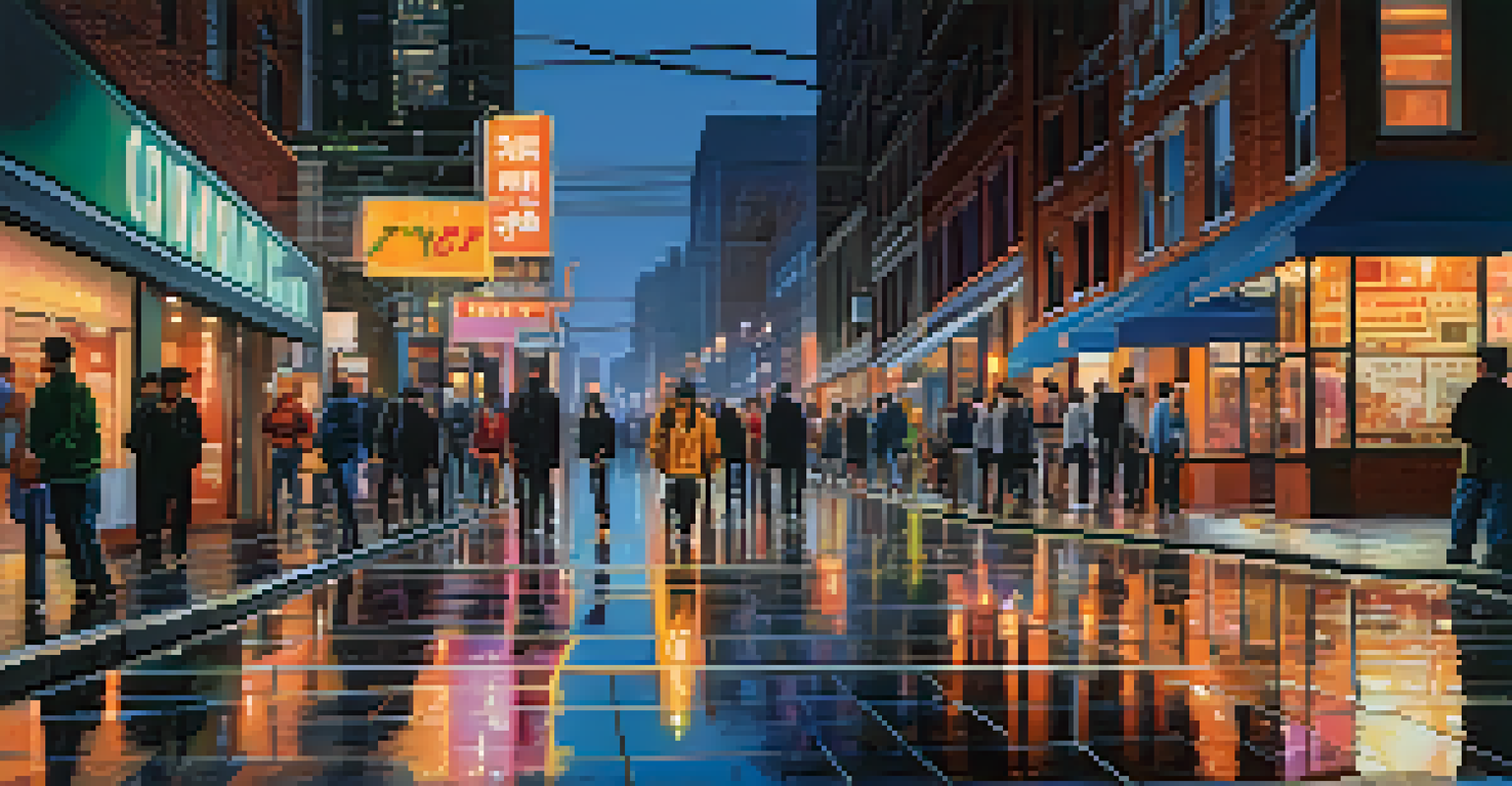The Role of Software in Enhancing Digital Photography Art

Understanding Digital Photography and Its Evolution
Digital photography has revolutionized how we capture images, shifting from traditional film to pixels. This transition has not only made photography more accessible but has also introduced a plethora of new tools and techniques. With the advancement of software, photographers can now manipulate images in ways that were previously unimaginable, paving the way for artistic expression.
Photography is the story I fail to put into words.
The evolution of digital photography means that anyone with a smartphone can become a photographer. As we explore the software that enhances this medium, it’s essential to recognize how it complements the photographer’s vision. This synergy between technology and artistry allows for more creativity and experimentation, giving rise to new styles and trends.
Ultimately, understanding the evolution of digital photography sets the stage for appreciating the role of software in this art form. It’s fascinating to see how far we’ve come, and how the tools at our disposal continue to shape what we can create today.
The Power of Editing Software in Photography
Editing software like Adobe Photoshop and Lightroom plays a crucial role in the digital photography landscape. These tools offer photographers the ability to enhance their images, adjust colors, and correct imperfections, turning a standard shot into a masterpiece. With just a few clicks, a dull image can become vibrant and full of life, highlighting the importance of these programs.

For instance, consider a landscape photo that captures a breathtaking view. With editing software, photographers can adjust the exposure and contrast to emphasize the sunset's colors, making the image more striking. This capability transforms mere documentation into an art form, allowing for storytelling through visuals.
Digital Photography's Accessibility
The shift from film to digital photography has made capturing images more accessible to everyone, especially with smartphone technology.
Furthermore, the learning curve for these software programs has decreased significantly over the years. Many platforms now offer user-friendly interfaces and tutorials, making it easier for aspiring photographers to master the art of editing, thus expanding their creative toolkit.
Color Grading: Setting the Mood with Software
Color grading is an essential aspect of digital photography that can dramatically alter the mood and tone of an image. Software tools allow photographers to manipulate hues, saturation, and brightness, enabling them to express emotions and themes visually. This process can turn an ordinary photo into something that resonates on a deeper level with viewers.
The best camera is the one you have with you.
Imagine a portrait where the subject’s eyes are the focal point. By enhancing the colors surrounding the eyes and softening the background, a photographer can create a captivating effect that draws the viewer in. This kind of artistry is made possible through the advanced features of color grading software, which can transform an image's narrative.
Moreover, color grading isn't just for personal expression; it also plays a significant role in branding and marketing. Businesses can use specific color palettes to evoke desired feelings, making software an invaluable tool in both personal and professional photography.
The Impact of Filters and Presets on Creativity
Filters and presets have become staples in digital photography, offering quick ways to enhance images. These tools allow photographers to apply specific adjustments with a single click, saving time while maintaining creative control. The convenience of filters can lead to a more spontaneous approach to photography, encouraging experimentation.
For instance, a photographer might use a vintage filter to give a modern photo an old-fashioned feel, creating a unique juxtaposition. This ability to transform the aesthetic of an image quickly can inspire photographers to explore new styles and techniques. As a result, filters and presets can act as a springboard for creativity, rather than a crutch.
Software Enhances Creative Expression
Advanced editing tools and AI are empowering photographers to enhance their images and streamline their creative processes.
Furthermore, the popularity of social media has fueled the demand for visually striking images, making filters more relevant than ever. Photographers can create a cohesive look for their portfolios or social media feeds, showcasing their style while engaging their audience effectively.
3D Software: Expanding the Boundaries of Photography
3D software is breaking new ground in the world of digital photography, allowing artists to create immersive experiences. By combining photography with 3D modeling, photographers can add depth and dimension to their work, pushing the limits of traditional photography. This integration represents an exciting frontier for creative exploration.
For example, imagine a photograph of a cityscape where the buildings appear to leap off the page thanks to 3D effects. This type of innovation enables photographers to tell stories that engage viewers in unique ways. The impact of 3D software is not just limited to visuals; it can also enhance the emotional connection between the art and its audience.
As 3D technology continues to evolve, we can expect even more groundbreaking applications in digital photography. This marriage of photography and technology opens up endless possibilities for artists, encouraging them to think outside the box and redefine their creative boundaries.
Artificial Intelligence: The Future of Photography Software
Artificial Intelligence (AI) is transforming the way photographers edit and manage their images. With tools powered by AI, tasks that once took hours can now be completed in minutes, thanks to automation and intelligent suggestions. This technology not only streamlines workflows but also enhances creative possibilities.
For instance, AI can analyze an image and suggest the best edits based on the style of the photographer. This feature is especially beneficial for beginners who may not yet have a refined eye for adjustments. By providing tailored recommendations, AI empowers photographers to produce stunning results without losing their unique flair.
Community Through Collaborative Platforms
Digital platforms enable photographers to share their work, receive feedback, and connect with a supportive community.
Moreover, AI is continually learning from user interactions, which means that the more it’s used, the better it becomes at predicting and enhancing edits. This ongoing evolution promises an exciting future for photography, where software becomes an indispensable ally in the creative process.
Sharing and Collaborating: Software's Role in Community Building
In today’s digital age, sharing and collaborating are vital aspects of the photography community. Software platforms allow photographers to showcase their work, receive feedback, and connect with others who share their passion. This connectivity fosters a sense of community, encouraging growth and inspiration.
For example, platforms like Instagram and Flickr provide spaces for photographers to share their work and interact with audiences worldwide. These social media tools not only promote individual artists but also facilitate collaboration on projects. Through shared creativity, photographers can learn from each other, push boundaries, and create remarkable pieces of art.

Furthermore, community-driven software tools often include features for critiques and peer reviews, which can be invaluable for improvement. By engaging with fellow photographers, artists can refine their skills, explore new ideas, and stay motivated in their artistic journey.
Conclusion: Embracing Software for Artistic Growth
The role of software in enhancing digital photography art cannot be overstated. From editing to sharing, the tools available today empower photographers to explore their creativity fully. Embracing these technologies allows artists to push the limits of their craft and produce work that resonates with audiences.
As we have seen, the integration of software into photography opens up countless opportunities for innovation and expression. Whether it’s through advanced editing techniques, 3D modeling, or AI assistance, the potential for growth is immense. Photographers who adapt to these tools will find new avenues for their artistry.
Ultimately, the fusion of software and photography represents a new era of artistic expression. As technology continues to evolve, so too will the possibilities for photographers, encouraging them to create, collaborate, and inspire in ways we have yet to imagine.